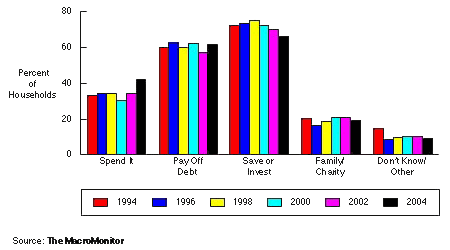First Peek at the 2004 Data MacroMonitor Marketing Report Vol. VII, No. 2 February 2005
In the past decade, U.S. households have been on a financial roller-coaster ride, careening upward in the go-go economy of the 1990s, falling steeply when the market bubble burst, and now lurching uncertainly in a so-so economy. The new 2004–05 MacroMonitor survey data (from 3,973 respondents during April through August 2004) reveal some major sea changes in the consumer-financial-services landscape. As we have observed many times in the past three decades, and similar to the second law of thermodynamics, financial consumers tend to continue to do what they have always done unless acted upon by a significant force. The events of the past four years are that type of a significant force. Consumers are now changing their attitudes and behaviors in virtually every sphere of financial services.
The implication of the shifts above and the more detailed, underlying changes within household segments, specific products, and channels is that financial providers who insist on staying the course or making only minor, incremental changes run the very real risk of losing market share. Those institutions that invest the time and effort to measure and understand the changing dynamics of today's consumers and appropriately alter and target their products, services, and marketing will be the ones that will benefit.
- Saving and investments. Incidences and amounts for most forms of savings and investments are down from two years ago for the first time since we began measuring them in 1978. Attitudes toward risk have shifted (back) toward the conservative.
- Retirement. Overall, the incidences of most retirement products have stagnated (annuities are the one exception!). However, the mean amounts held in these products have moved in different directions, depending on the cohort. Attitudes toward retirement indicate a similar stagnation, with majorities concerned about their adequacy.
- Planning and advice. In a counterintuitive, yet overwhelmingly consistent pattern, financial consumers are less likely to have paid for financial advice anytime since 1996. Not only is the incidence of having recently obtained advice down for each of the major advisory areas (tax, investment, retirement, and so forth), but so are incidences indicating that households are likely to obtain advice in the coming year. Commensurate with this decline are related decreases in the recent use of most types of financial advisors, as well as in plans to do so next year.
- Credit cards. The household incidence of owning any type of credit card has significantly declined for the first time in at least the past decade if not ever. Supporting this pattern is a decline in the number of accounts in many cohorts of households. At the same time, other forms of transaction vehicles—such as debit cards, automatic payments from accounts, telephone payments, and Internet payments—are increasing.
- Debt and credit. The amount and incidence of overall debt among U.S. households continues to rise. Overall, some 92 million households have some outstanding debt, and the average amount of $68,000 reflects a 13% increase from 2002 and a 70% increase from just a decade ago (not taking account for inflation).
- Online financial services. Household penetration of computers and access to the Internet continue to climb, but that rate of increase is slowing. Similarly, use of the Internet for financial services continues to climb, but that increase is also slowing, especially for investing transactions.
- Insurance.The incidence of group and individual life insurance is stable, as is that of most forms of property and casualty insurance. Almost all forms of health and health-related insurance—such as supplemental, eye, and disability—have lower incidences than two years ago, especially for group policies.
What Would You Do with a $25,000 Windfall? |
The implication of the shifts above and the more detailed, underlying changes within household segments, specific products, and channels is that financial providers who insist on staying the course or making only minor, incremental changes run the very real risk of losing market share. Those institutions that invest the time and effort to measure and understand the changing dynamics of today's consumers and appropriately alter and target their products, services, and marketing will be the ones that will benefit.